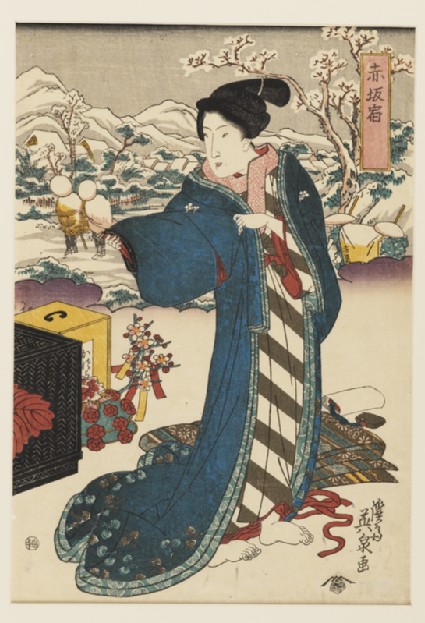Browse: 10610 objects
- Reference URL
Actions
Akasaka Station
-
Details
- Series
- Beauties for the Tōkaidō Road
- Associated place
- Date
- 1843 - 1847
- Artist/maker
-
Keisai Eisen (1791 - 1848) (designer)
- Associated people
-
Tsutaya Kichizō (active c. 1830 - 1880) (publisher)
- Material and technique
- nishiki-e (multi-block) woodblock print, with bokashi (tonal gradation), printed with water-based vegetable pigments
- Dimensions
-
mount 55.9 x 40.6 cm (height x width)
print 37 x 25.4 cm (height x width)
- Material index
- Technique index
- Object type index
- No. of items
- 1
- Credit line
- Presented by Christ Church College, University of Oxford, 1983.
- Accession no.
- EA1983.77
-
Further reading
Oxford: Ashmolean Museum, 24 August-30 November 2005, Beauties of the Four Seasons, Mitsuko Watanabe, ed. (Oxford: Ashmolean Museum, 2005), no. 36 on p. 76, illus. p. 77
Glossary (2)
nishiki-e, vegetable pigments
-
nishiki-e
Nishiki-e literally means 'brocade pictures' and refers to multi-coloured woodblock prints.
-
vegetable pigments
Vegetable pigments were used to create coloured dyes for Japanese prints, paintings, and textiles. These pigments often faded over time due to the chemical reactions they underwent.
Location
-
- currently in research collection
Objects are sometimes moved to a different location. Our object location data is usually updated on a monthly basis. Contact the Jameel Study Centre if you are planning to visit the museum to see a particular object on display, or would like to arrange an appointment to see an object in our reserve collections.
Publications online
-

Beauties of the Four Seasons
During the Bunsei era (1818-30) the Eisen style of bijinga became popular, displacing that of Kikukawa Eizan. Although he was a landscape artist similar to Hiroshige, his style of portraying beauty was dramatic and gives a feeling of decadence, differing from previous artists. Eisen incorporated beauties and landscape into his series of the Bijin Tōkaidō which consists of 40 images. In each image, a beauty stands in the foreground while, with a Genji-kumo (Genji-style cloud) as a partition, a scene of a landscape is depicted in the background. In an earlier version of this series, published in the end of Tenpo era (1831-40), there are poems inscribed on each of the scenes.
This print show a beauty putting on her padded blue kimono at the 36th station of the Tōkaidō, the Akasaka-yado. The combination of the lady with various kimono accessories including a box containing wigs on the ground, and people wearing straw hats in the snow in the background, suggests winter or ealy spring.
© 2013 University of Oxford - Ashmolean Museum

